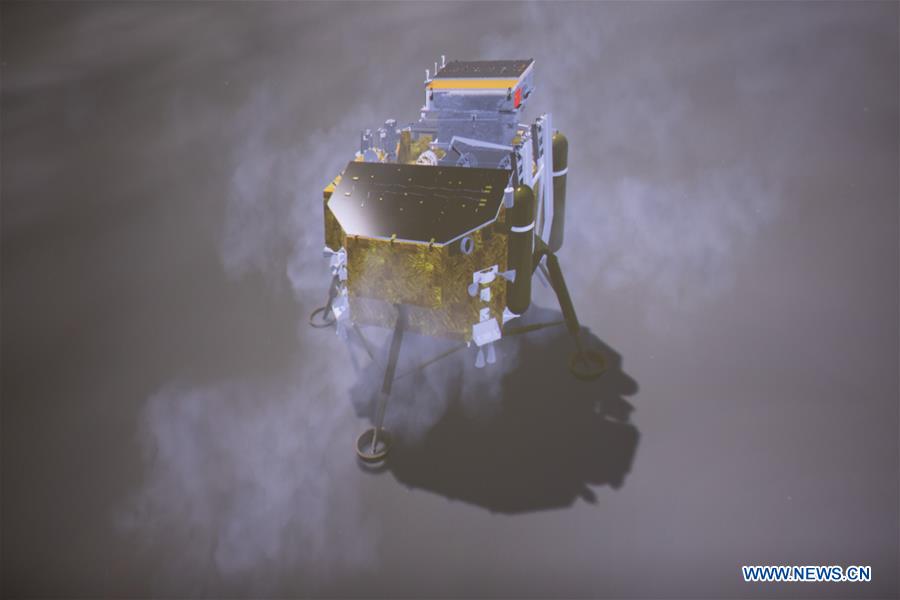
A simulated landing process of Chang'e-4 lunar probe is seen through the monitor at Beijing Aerospace Control Center in Beijing, capital of China, Jan. 3, 2019. China's Chang'e-4 probe touched down on the far side of the moon Thursday, becoming the first spacecraft soft-landing on the moon's uncharted side never visible from Earth. The probe, comprising a lander and a rover, landed at the preselected landing area on the far side of the moon at 10:26 a.m. Beijing Time (0226 GMT), the China National Space Administration announced. (Xinhua/Jin Liwang)
BEIJING, Jan. 3 (Xinhua) -- China's Chang'e-4 probe touched down on the far side of the moon Thursday, becoming the first spacecraft soft-landing on the moon's uncharted side that is never visible from Earth.
The probe, comprised of a lander and a rover, touched down at the preselected landing area at 177.6 degrees east longitude and 45.5 degrees south latitude on the far side of the moon at 10:26 a.m. (Beijing Time), the China National Space Administration (CNSA) announced.
With the communication assistance of the relay satellite Queqiao, meaning Magpie Bridge, the probe sent back the first-ever close-up photograph of the moon's far side, opening a new chapter in lunar exploration.
After the Beijing Aerospace Control Center sent an order at 10:15 a.m., the Chang'e-4 probe, launched on Dec. 8, 2018, began to descend from 15 km above the moon with a variable thrust engine being ignited, said CNSA.
The Chang'e-4's relative velocity to the moon was lowered from 1.7 km per second to close to zero, and the probe's attitude was adjusted at about 6 to 8 km above the lunar surface.
At 100 meters up, the probe hovered to identify obstacles and measured the slopes on the surface. After avoiding the obstacles, it selected a relatively flat area and descended vertically and slowly.
Then the probe landed in the Von Karman Crater in the South Pole-Aitken Basin.
During the descending process, a camera on the probe took photos of the landing area.
After landing, the solar panels and antennas on the probe were unfolded under the control of the space engineers in Beijing through the communication transmission of the relay satellite, which was operating in the halo orbit around the second Lagrangian (L2) point of the earth-moon system, about 65,000 km from the moon, where it can see both Earth and the moon's far side.
The first close-up photo of the moon's far side, taken by a monitoring camera on the lander at 11:40 a.m., showed the direction the rover would drive on to the lunar surface.
The control center in Beijing will choose a proper time to let the rover separate from the lander, according to CNSA.
The Chang'e-4 probe, carrying eight payloads including two developed through international cooperation, will conduct low-frequency radio astronomical observation, survey the terrain and landforms, detect the mineral composition and shallow lunar surface structure and measure the neutron radiation and neutral atoms to study the environment on the far side of the moon, according to CNSA.
The mission provides the world's scientists more opportunities to explore the universe.
The moon is tidally locked to Earth, rotating at the same rate that it orbits Earth. Therefore, only one side of the moon is seen from Earth, leaving the far side a mystery before the age of spacecraft.
Many lunar orbiters have shown the moon's two sides are very different: the near side has more and relatively flat lunar mares, while the far side is thickly dotted with impact craters of different sizes.
Scientists infer that the lunar crust on the far side is much thicker than the near side. However, the reality is still a mystery, and only in-situ exploration might reveal the secrets.
For astronomers, the far side of the moon is a place of ideal tranquility, as the body of the moon shields against radio interference from Earth. From there, they could study the origins and evolution of stars and galaxies, peering into the dawn of the universe.
Chang'e-4's low-frequency radio astronomical observation on the moon's far side will fill gaps in astronomical observation.



